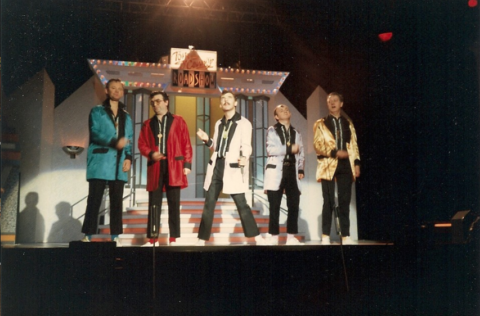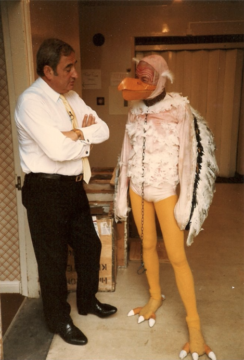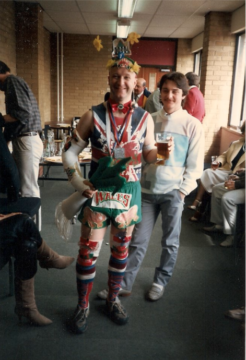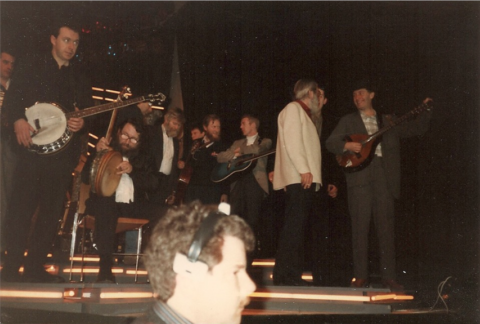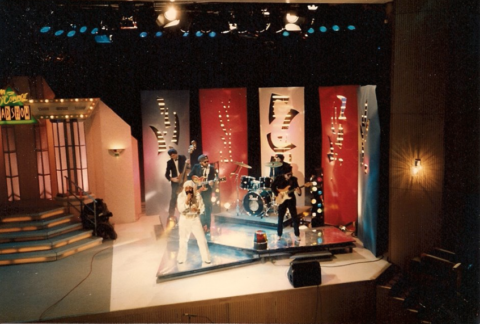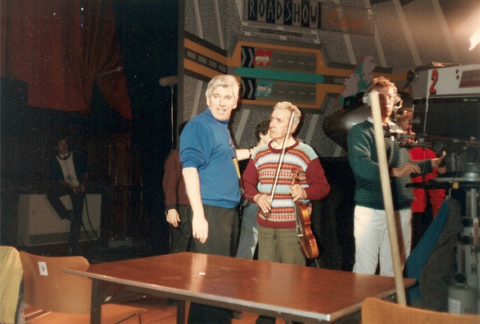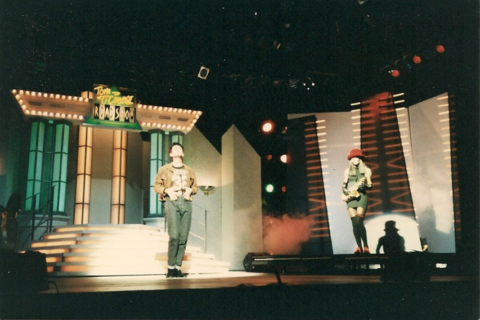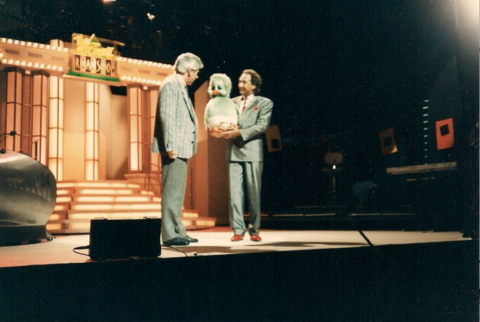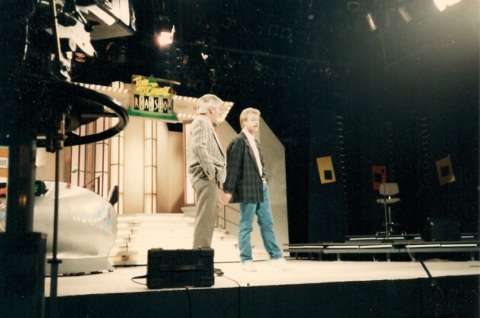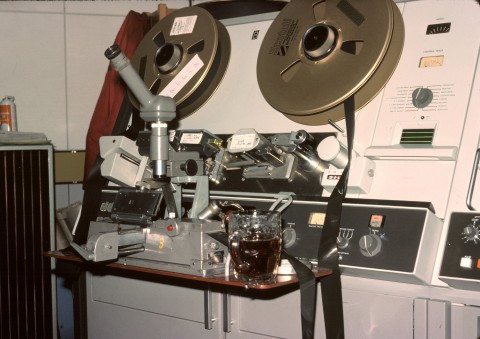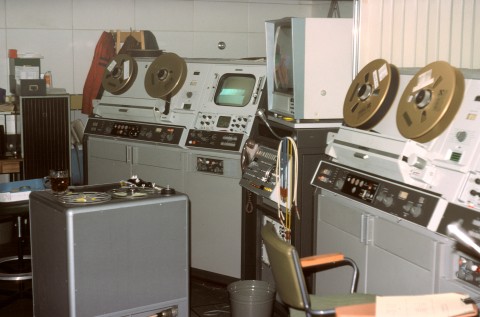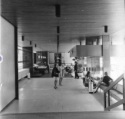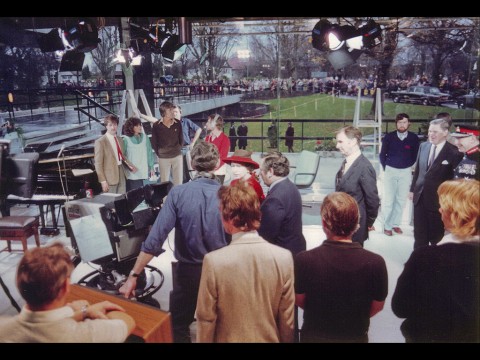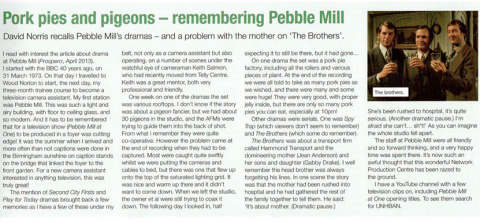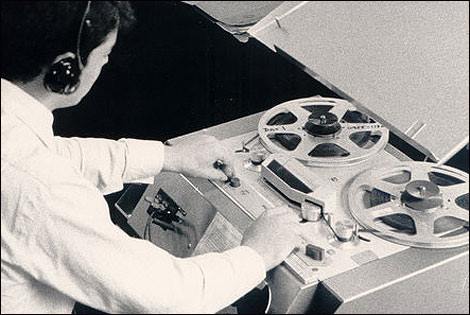
Copyright resides with the original holder, no reproduction without permission.
The photo is of a Phillips 1/4″ audio editing machine, apparently from Radio Stoke.
The following exchange took place on the Pebble Mill Facebook group:
Keith Brook: ‘Ah, the Phillips ¼” machine. Absolutely the best editing machine ever!! Most came with a dark green BBC waste basket on the right!!’
Pete Simpkin: ‘Keith are we speaking of the same machine..the Phillips I know and hate was in a grey box and was very good at stretching and spilling tape whilst editing. The official green BBC waste box I am sure was on the trolley mounted TR90 which really WAS the best editing machine!…or am we both suffering from Tempus Fugit.’
Keith Brook: ‘Pete, I’ve been searching for a picture of the Phillips beast but TR90 does ring a bell. I first used them in local radio in the late 60s and then when I arrived at Pebble Mill as a cameraman, they were at the back of Studio B gallery. They had a slanted shelf on top for scripts. The best part was that you marked the tape on a pillar and then just dragged the tape to the block. The brakes came off as you pulled the tape making editing very quick. Some of us just used our fingernail to push into the pillar, thus saving valuable seconds. Is that the one?’
Pete Simpkin: ‘Yes that’s the Phillips!’
Keith Brook: ‘The reference to the waste bin on the right hand side was that journos, in typical last minute haste to make the story appear important, would throw me a 5″ spool with their piece and a bad carbon copy of the link before rushing into the studio.’
Pete Simpkin: ‘One of my dislikes of the Philips was that one election evening I was intake tape operator and had just recorded a declaration and was splicing a leader on to it when the producer called for the replay immediately, because of the floppy take up on the machine as I attempted to line up the start again, I nicked my finger with the razor blade which I was still holding and as the declaration was replayed there was blood pouring out of the head box!!’
Keith Brook: ‘Just to the right of the pinch roller is the marking post, with a line in it, that you refer to when you’ve waggled the sound about to find the edit point. You make a china-graph mark on the tape and, thanks to the lovely braking system on the Philips, you can easily drag that mark to the edit block which is just under that guy’s hand. You cut it at 45deg on the block and leave the right hand part there. Now, you can easily pull the left hand, incoming tape with your hands and listen until you’ve reached the next edit point. Mark it, pull it to the block, stick some editing tape over the join and you’re done!! Some of us pre-loaded 1″ strips of editing tape onto the backs of our hands for speed. Journos weren’t very good at this, or anything else for that matter, and cut on the end of the outgoing sentence and the beginning of the incoming sentence. Leaving the breath in before or after the edit made it sound much more natural and didn’t take up any extra time.’
Paul Freeman: ‘That is STILL my favourite reel-to-reel machine: I bought one on Ebay a while back but, not being an ex-BBC m/c it lacks the framing and top shelf for keeping your script on, and the pegs to hold the leader and sticky. If you didn’t bite your nails it was easy to edit on this without a chinagraph, you picked up the tape in both hands, lining your rt thumb-nail with the pillar mark, and transferred it to the edit block lining your thumb-nail with the line on the block – Simples! Wish I had one of these machines I also need the Philips pre-amp set for it if anyone ever comes across one. Curiously, it seems the neon record light, and the sleeve around the red button are BBC mods too.’
Keith Brook: ‘Yes, the thumbnail trick was a good one, but I just kept the tape running after I’d stuck my nail in and that gave me enough tape to pull over to the block.’
Pete Simpkin: ‘Any sweat…sorry perspiration…. on your fingers would have covered the coated side and made the joins audible because of the loss in top frequencies as the tape passed over the repro head!’
Keith Brook: ‘Pete, we used white gloves at Radio Merseyside. Didn’t everybody?’
Paul Freeman: ‘Pete, either we had tape stock which wasn’t susceptible to sweat, or we had preternaturally dry hands! Besides, who’s touching the edit? I’m handling it 8 inches either side ! The only person I ever saw wearing white gloves was Milton Hainsworth, and that was to grip the film to remove the chinagraph marks as he rewound the make-up, usually at far too few minutes before TX!’
Keith Brook: ‘Most of this discussion is about editing on the Philips. Here’s a close up of the marker post we keep talking about. See? It even has a groove for Paul Freeman’s finger nail!!
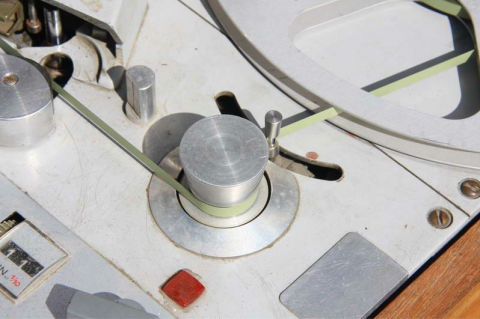
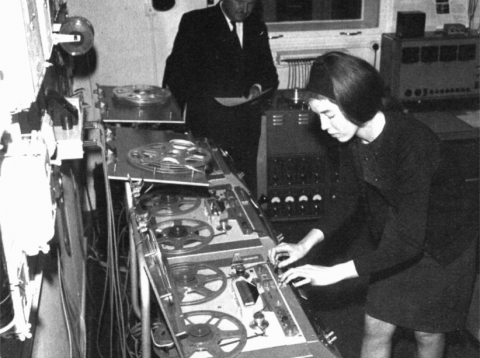
Delia Derbyshire editing on the Phillips 1/4″. Photo from Keith Brook
Keith Brook: ‘Here’s a picture of Delia Derbyshire, the wonderfully talented lady who created the Dr Who theme from Ron Granger’s original notes.’
Pete Simpkin: ‘OK Keith if the Philips tape M/C gave us Dr Who’s theme what can I say! Great discussion though!’
Paul Freeman: ‘One of the great things about these machines was their simplicity: both in loading and function, important factors in news operation. They laced up so fast it was quite possible to go from a tape in a box (or more likely with a page of cue jammed in it) to pressing the play button in under 2 seconds. In a REAL emergency, you didn’t even need to spin it onto the take-up spool, you could spool it unto the floor – something you couldn’t do with those wretched Studers, and you certainly couldn’t lace a tape onto a Leever-Rich in under about 5 seconds. They were tolerant of small inserts (like a 30″ sound bite, for instance) on standard 5″ spools whereas many of the other machines would snatch if it wasn’t on a ‘W’. All in all, a shining example of something fit-for-purpose.’
